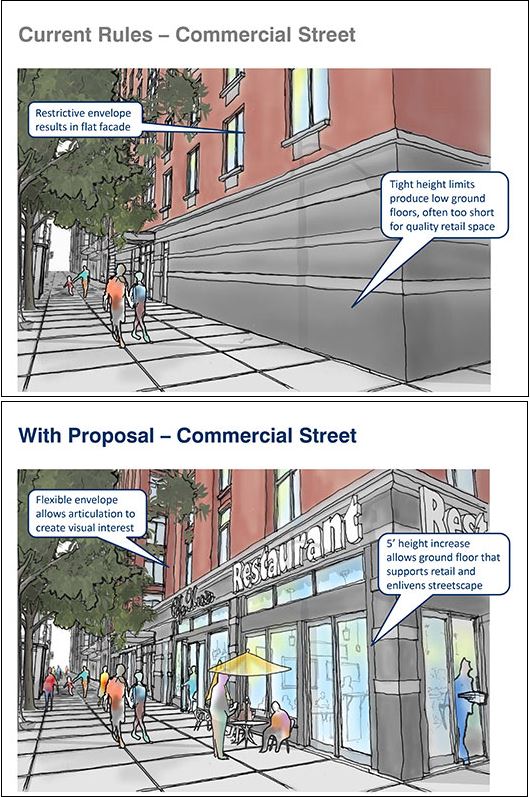Photo Courtesy of DCP
Representatives from the Department of City Planning on Monday presented the “Zoning for Quality and Affordability” and “Mandatory Inclusionary Housing” proposed zoning text amendments to the Borough Board at Borough Hall.
The six-month public review process on both amendments began late September and requires review by community boards, borough presidents, Borough Boards, the City Planning Commission and the City Council.
“The goals of quality and affordability are complementary: it is essential that we achieve both,” City Planning Commission Chairman Carl Weisbrod said last month. “Zoning for Quality and Affordability will address longstanding concerns about our zoning rules to help make the City more affordable to a wide range of New Yorkers, and foster diverse, livable communities with buildings that contribute to the character and quality of neighborhoods.”
The Zoning for Quality and Affordability proposed text amendment, according to DCP, would amend zoning regulations to encourage better buildings and accommodate the needs of mixed-income and affordable housing. The proposal would encourage better architecture and good design with targeted changes to rules in medium- and higher-density neighborhoods, and would allow taxpayer dollars and investments that go into affordable housing and senior housing under the de Blasio administration’s 10-year Housing New York plan to go further.
Some of the proposal’s highlights include:
In medium- and high-density districts, encourage buildings to provide ground floors that include better space for retail where permitted and a better relationship to the street, by allowing limited additional height (in over 95 percent of areas, no more than 5 feet). This additional height would be available only where taller ground floors are provided. The number of stories in the building would be capped.
Change rules that today lead to flat, dull apartment buildings to encourage visual variety and features common in traditional residential buildings, such as bay windows and courtyards.
Maintain rules that work well today, including the essential rules of “contextual” zoning districts and lower-density zoning districts.
Enable Inclusionary Housing buildings, which provide mixed-income housing, to construct quality buildings that fit the full amount of housing they are allowed under zoning today.
Rationalize definitions under zoning to make it easier to provide the range of affordable senior housing and care facilities needed to meet the varied needs of an aging population, and to help seniors remain in their communities. In addition, in lower density districts that permit multifamily housing, modify zoning that today produces walkup buildings in order to allow affordable senior apartments to be built in a building served by an elevator, not exceeding four to six stories.
Reduce unnecessarily high costs of building transit-accessible affordable housing by making off-street parking spaces optional, rather than required, for new affordable and affordable senior housing developments near transit. This will allow taxpayer dollars to go toward more housing or better open space rather than unnecessary parking spaces.
The Mandatory Inclusionary Housing program would require (through zoning) that when City Planning Commission actions create significant new housing capacity in medium and high-density areas, either 25 or 30 percent of new housing would be permanently affordable. MIH is intended to promote economic diversity in neighborhoods where the city plans for growth by ensuring that new housing meets the needs of a wider range of New Yorkers, according to DCP.
Production of affordable housing would be a condition of residential development when developers build in an area zoned for Mandatory Inclusionary Housing, whether rezoned as part of a city neighborhood plan or a private rezoning application. As “enabling legislation,” the proposed text amendment would establish a framework that would then be applied as neighborhoods are rezoned throughout the city, DCP noted.
The program would be applied to DCP’s neighborhood rezonings where housing capacity significantly increases, beginning with East New York. It would also apply to individual applications, private or public, to the City Planning Commission where a significant amount of new housing capacity is created. Each would go through its own land use review process.
“Mandatory Inclusionary Housing is designed to be predictable, feasible and permanent,” Weisbrod said. “It would foster economic diversity in neighborhoods. Most important to residents is that it will assure that the affordable housing units are affordable forever and protected, regardless of what happens to neighborhoods over time, enabling us to create and sustain a long-term stable reservoir of affordable housing for our communities.”
DCP has indicated that Mandatory Inclusionary Housing is one of several tools to create new affordable housing under de Blasio’s ambitious HNY plan, and can be combined with subsidies to achieve broader and deeper affordability. Acknowledging that neighborhoods may have greater economic need than can be met by MIH alone, under each DCP neighborhood planning initiative, the city Department Housing Preservation and Development and DCP will evaluate the area to determine the role that HPD programs could play in broadening and deepening affordability.
By Michael V. Cusenza
michael@theforumnewsgroup.com

